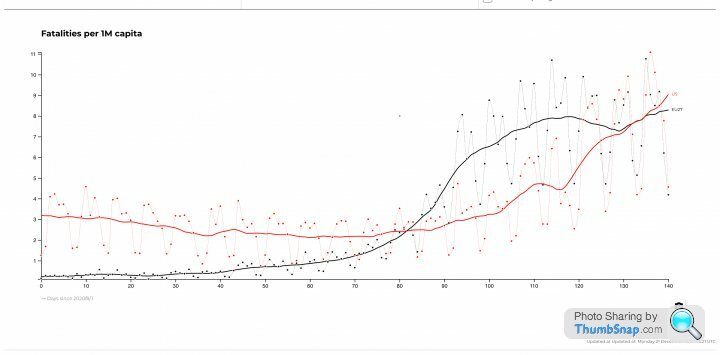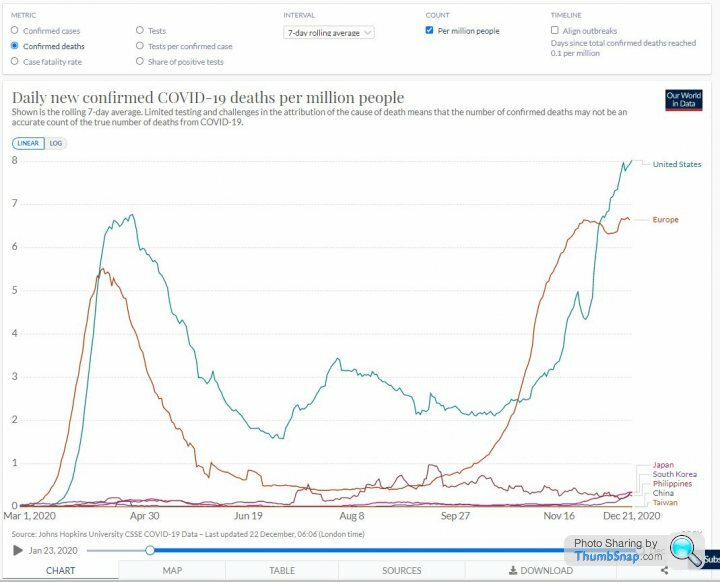Coronavirus - Data Analysis Thread
Discussion
A number of people have suggested we should have a separate thread for analysis of the data around the pandemic. The idea being that this should be factual and free from arguments, conspiracy theories and mask wars.
I can't see it lasting, but I am willing to give it a go.
To kick us off. Two charts to put 2020 all cause deaths into perspective:
1. A heat map of ONS all cause deaths for 2010-2019, adjusted for ONS population estimates with 2019 as the benchmark. The 2020 is actual:
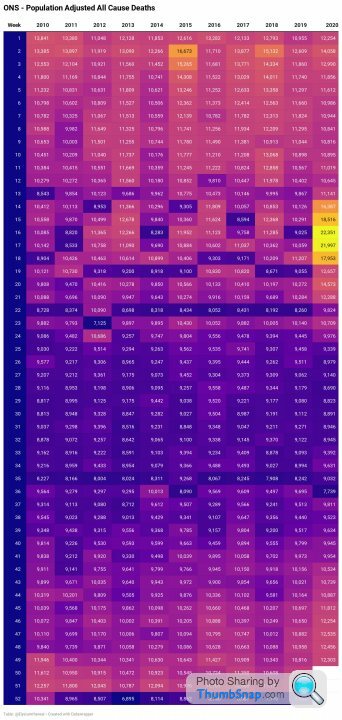
2. The same data presented as a graph
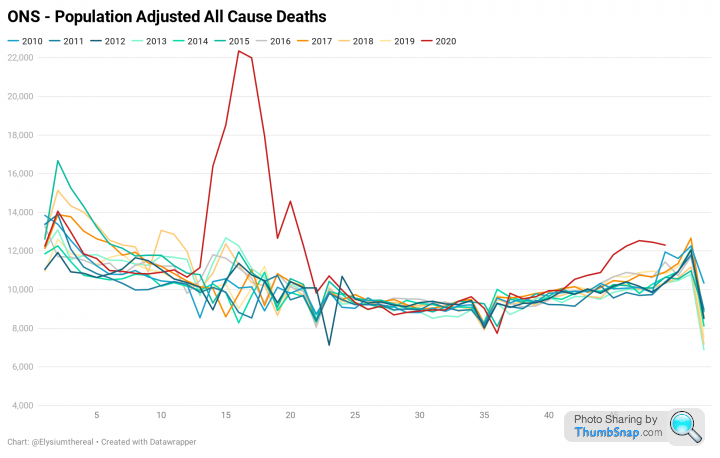
The Spring outbreak is clearly much more significant than the autumn one.
I can't see it lasting, but I am willing to give it a go.
To kick us off. Two charts to put 2020 all cause deaths into perspective:
1. A heat map of ONS all cause deaths for 2010-2019, adjusted for ONS population estimates with 2019 as the benchmark. The 2020 is actual:

2. The same data presented as a graph

The Spring outbreak is clearly much more significant than the autumn one.
Edited by Elysium on Sunday 20th December 14:53
This graph divides all cause deaths into those 'due to' COVID and those where COVID is not noted as a cause of death.
Data is from ONS and population adjusted to the 2019 population. The dotted lines are the 5 year minimum, average and maximum and the green line is the point at which 2020 becomes 'statistically significant', which is 2 x standard deviations from the average:
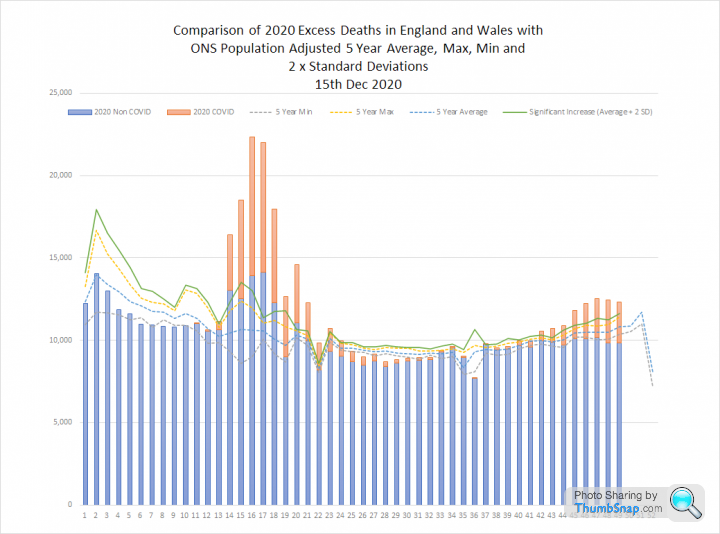
This shows statistically significant non-COVID excess deaths in the spring outbreak, but in the Autumn non-COVID deaths are below the 5 year minimum.
Data is from ONS and population adjusted to the 2019 population. The dotted lines are the 5 year minimum, average and maximum and the green line is the point at which 2020 becomes 'statistically significant', which is 2 x standard deviations from the average:

This shows statistically significant non-COVID excess deaths in the spring outbreak, but in the Autumn non-COVID deaths are below the 5 year minimum.
I also wanted to share this simple graph, which shows COVID deaths and Excess deaths (variance from the 5 year average) throughout 2020:
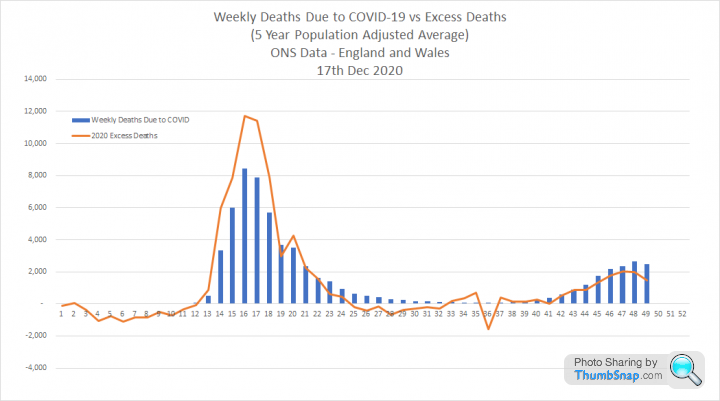
Spring excess deaths are approximately 5 times higher than Autumn, which I think provides some context for the relative scale of each 'wave'.

Spring excess deaths are approximately 5 times higher than Autumn, which I think provides some context for the relative scale of each 'wave'.
Edited by Elysium on Sunday 20th December 15:05
This graph shows the 7 day average of cases for London and Wales. I have identified the time periods where the Welsh Firebreak and English Lockdown could have had an impact on transmission.
Data here: https://coronavirus.data.gov.uk/details/cases
Both show a dip during tighter restrictions with a rapid rebound. London has rebounded harder, but was growing faster prior to restrictions. The dip at the end is reporting lag:

Data here: https://coronavirus.data.gov.uk/details/cases
Both show a dip during tighter restrictions with a rapid rebound. London has rebounded harder, but was growing faster prior to restrictions. The dip at the end is reporting lag:

Edited by Elysium on Sunday 20th December 15:28
This graph helps illustrate the potential hidden scale of the pandemic.
Cases, admissions and deaths from here: https://coronavirus.data.gov.uk/
The infection curve is calculated from daily deaths assuming a constant IFR of 0.6% and a time from infection to death of 21 days:

I believe this shows the vast scale of infections that was probable in the spring, but that we were completely unable to detect. And also that, despite massive increases in testing and case numbers we may still be missing a great many cases in the autumn.
Admissions and are deaths barely visible at this scale.
Cases, admissions and deaths from here: https://coronavirus.data.gov.uk/
The infection curve is calculated from daily deaths assuming a constant IFR of 0.6% and a time from infection to death of 21 days:

I believe this shows the vast scale of infections that was probable in the spring, but that we were completely unable to detect. And also that, despite massive increases in testing and case numbers we may still be missing a great many cases in the autumn.
Admissions and are deaths barely visible at this scale.
Edited by Elysium on Monday 21st December 23:09
oyster said:
Elysium said:
This graph helps illustrate the hidden scale of the pandemic.
Cases, admissions and deaths from here: https://coronavirus.data.gov.uk/
The infection curve is calculated from daily deaths assuming a constant IFR of 0.6% and a time from infection to death of 21 days:

This shows the vast scale of infections that was likely in the spring, but that we were completely unable to detect. It also shows that, despite massive increases in testing and case numbers we must still be missing a great many cases in the autumn.
Admissions and are deaths barely visible at this scale.
What’s the sum total of the area under the infections graph?Cases, admissions and deaths from here: https://coronavirus.data.gov.uk/
The infection curve is calculated from daily deaths assuming a constant IFR of 0.6% and a time from infection to death of 21 days:

This shows the vast scale of infections that was likely in the spring, but that we were completely unable to detect. It also shows that, despite massive increases in testing and case numbers we must still be missing a great many cases in the autumn.
Admissions and are deaths barely visible at this scale.
We know the sum under the cases graph is circa 2m.
Extrapolated out, that graph suggests herd immunity isn’t so far away.
So the area under the curve will be 67,401/.006 = 11.23 million, which is 19% of the 2019 England and Wales population.
Some other interesting data sites:
1. A COVID 'tier' visualiser, which is now somewhat overtaken by events.
https://coviddatashare.s3-eu-west-1.amazonaws.com/...
2. This website lets you display a number of data sets by area:
https://victimofmaths.shinyapps.io/COVID_LA_Plots/
3. Swedens live numbers:
https://c19.se/
4. A great site to compare latest info by country:
https://datagraver.com/corona/#/
1. A COVID 'tier' visualiser, which is now somewhat overtaken by events.
https://coviddatashare.s3-eu-west-1.amazonaws.com/...
2. This website lets you display a number of data sets by area:
https://victimofmaths.shinyapps.io/COVID_LA_Plots/
3. Swedens live numbers:
https://c19.se/
4. A great site to compare latest info by country:
https://datagraver.com/corona/#/
I have no idea how to share the data set behind these graphs, but it is all taken directly from here:
https://coronavirus.data.gov.uk/
My cases per 100k graph compares positive cases by specimen date to tests processed two days later.
1. Tests and Cases. Although cases have been increasing, we have also been testing more, topping 440k tests processed in a day for the first time. This suggests to me that we have reversed the lockdown 'dip', so what happens next will be interesting:
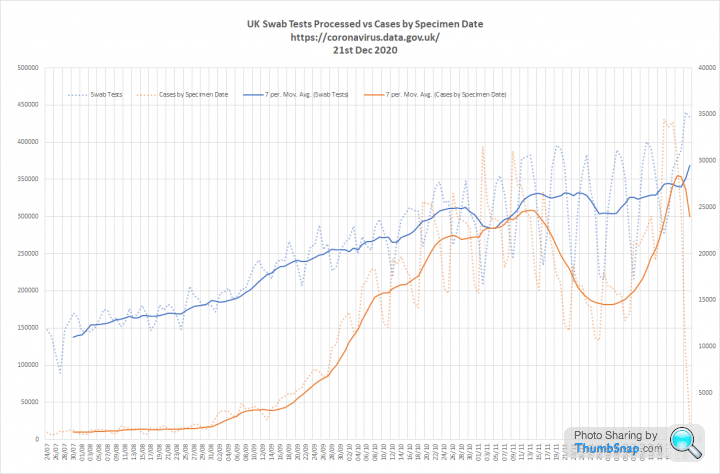
2. Cases per 100k tests, admissions and deaths. Cases and admissions now showing an uptick. Deaths will follow:
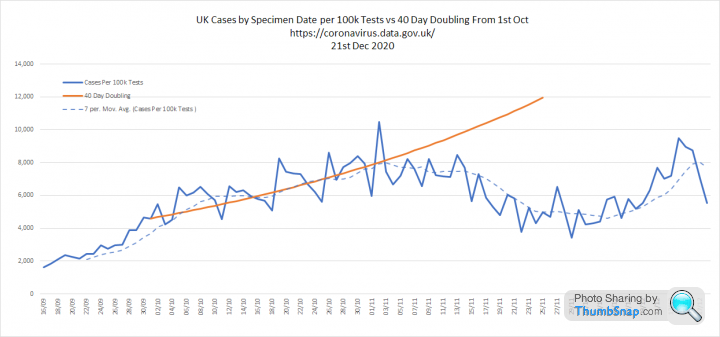
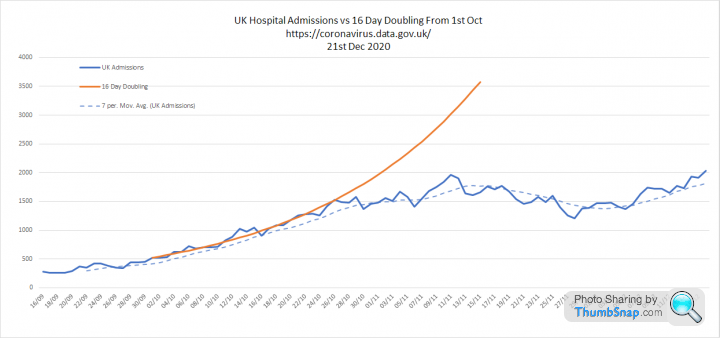
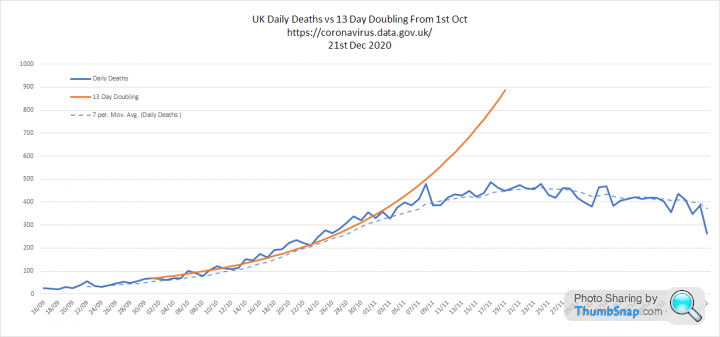
3. Overlay of the above and corresponding growth rates:
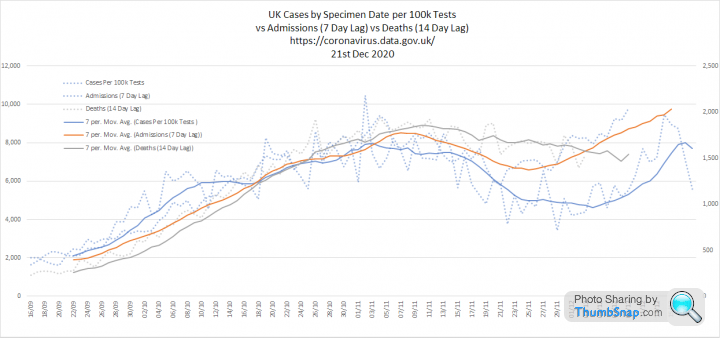
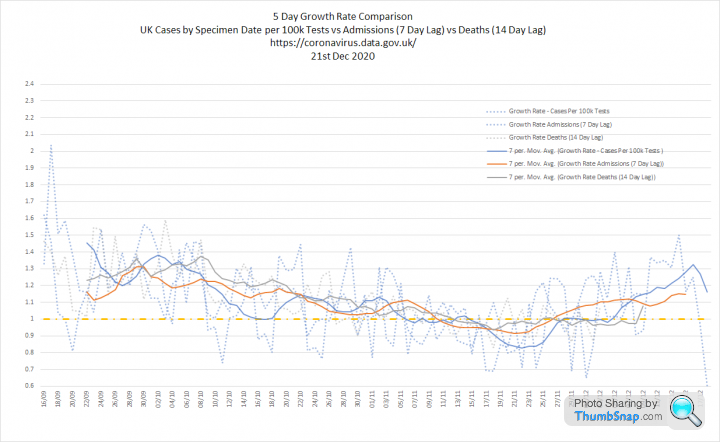
https://coronavirus.data.gov.uk/
My cases per 100k graph compares positive cases by specimen date to tests processed two days later.
1. Tests and Cases. Although cases have been increasing, we have also been testing more, topping 440k tests processed in a day for the first time. This suggests to me that we have reversed the lockdown 'dip', so what happens next will be interesting:

2. Cases per 100k tests, admissions and deaths. Cases and admissions now showing an uptick. Deaths will follow:



3. Overlay of the above and corresponding growth rates:


bigandclever said:
coanda said:
bigandclever said:
That’s not data, it’s a terrible, unintelligible chart.
Let's see your attempt at answering Otis' question then.eg

When comparing countries Sweden and UK normally come up because the timing of their epidemic curves is similar and they have different lockdown policies. People also argue that Sweden should be compared to neighbouring states.
This is from Euromomo, where you can choose countries to compare z-scores and zoom in on a particular timescale. In this case all of 2020:
https://www.euromomo.eu/graphs-and-maps/#
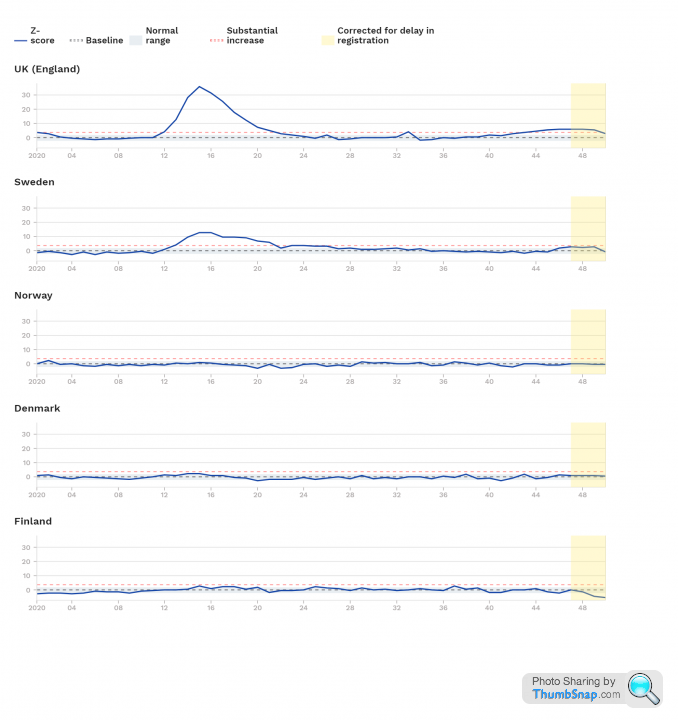
UK lockdown was wk 13, so if we assume 3 weeks from infection to death the impacts should be seen wk 16.
This comparison between Sweden and neighbouring states suggests they faced difficult levels of infection between wks 13 and 16.
This is from Euromomo, where you can choose countries to compare z-scores and zoom in on a particular timescale. In this case all of 2020:
https://www.euromomo.eu/graphs-and-maps/#

UK lockdown was wk 13, so if we assume 3 weeks from infection to death the impacts should be seen wk 16.
This comparison between Sweden and neighbouring states suggests they faced difficult levels of infection between wks 13 and 16.
ONS data published today:
https://www.ons.gov.uk/peoplepopulationandcommunit...
This shows ONS all cause deaths with those 'due to' COVID highlighted in orange. The dotted lines are the average, max and min for 2015-2019 adjusted for the 2019 population. The solid green line is the limit of statistical significance or 2 x standard deviations from the average.
I think it is interesting that we had sigificant non-COVID excess death in the spring, but non-COVID deaths are now below the 5 year minimum. This requires further explanation.
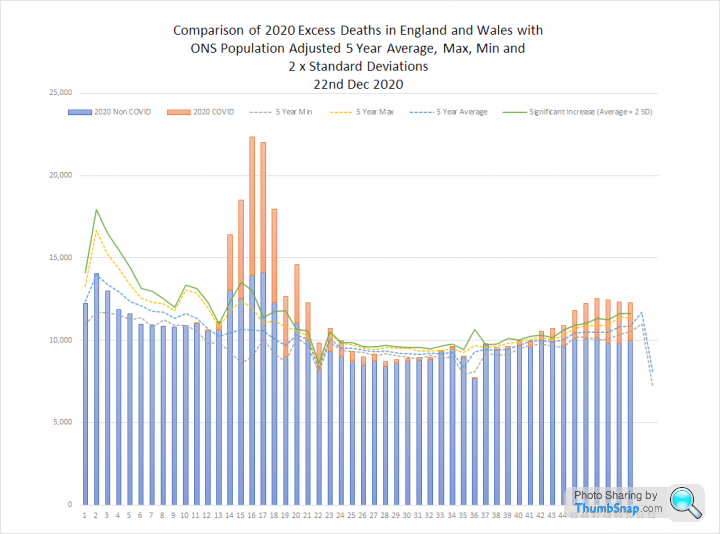
This second graph uses the same data set, to show 'due to COVID' deaths and excess deaths. I think this gives a good idea of the relative scale of the spring and autumn outbreaks:
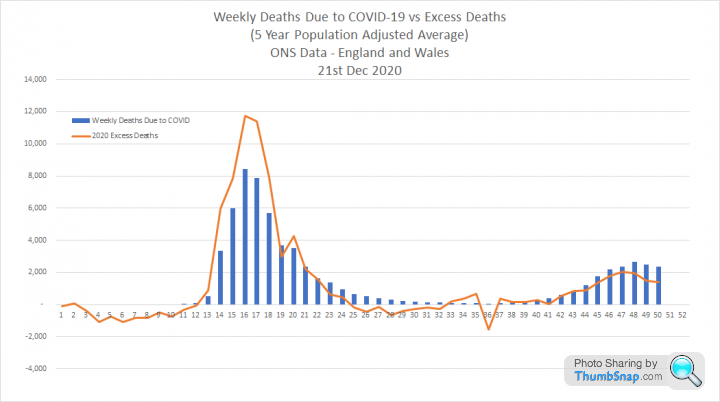
https://www.ons.gov.uk/peoplepopulationandcommunit...
This shows ONS all cause deaths with those 'due to' COVID highlighted in orange. The dotted lines are the average, max and min for 2015-2019 adjusted for the 2019 population. The solid green line is the limit of statistical significance or 2 x standard deviations from the average.
I think it is interesting that we had sigificant non-COVID excess death in the spring, but non-COVID deaths are now below the 5 year minimum. This requires further explanation.

This second graph uses the same data set, to show 'due to COVID' deaths and excess deaths. I think this gives a good idea of the relative scale of the spring and autumn outbreaks:

survivalist said:
Otispunkmeyer said:
Elysium said:
This graph shows the 7 day average of cases for London and Wales. I have identified the time periods where the Welsh Firebreak and English Lockdown could have had an impact on transmission.
Data here: https://coronavirus.data.gov.uk/details/cases
Both show a dip during tighter restrictions with a rapid rebound. London has rebounded harder, but was growing faster prior to restrictions. The dip at the end is reporting lag:

Like I replied in the other thread. Looks like lockdown does have an effect. It is just short lived and doesn't effect the eventual outcome given what looks like a quick "reversion to the mean" once the restrictions stop.Data here: https://coronavirus.data.gov.uk/details/cases
Both show a dip during tighter restrictions with a rapid rebound. London has rebounded harder, but was growing faster prior to restrictions. The dip at the end is reporting lag:

Edited by Elysium on Sunday 20th December 15:28
So perhaps there is a use for them. But the expectations should be that it's not going to make the virus go away. It will come straight back again the moment you emerge. Obviously we cannot lockdown ad infinitum, but perhaps they can be used to buy some time for the services.
But then we are not seeing anything like as bad as it was in spring, so are they actually being genuinely useful?

It’s effectively the ONS excess deaths data, but I think this is a great ‘Florence Nightingale’ graph shared by Carl Heneghan:
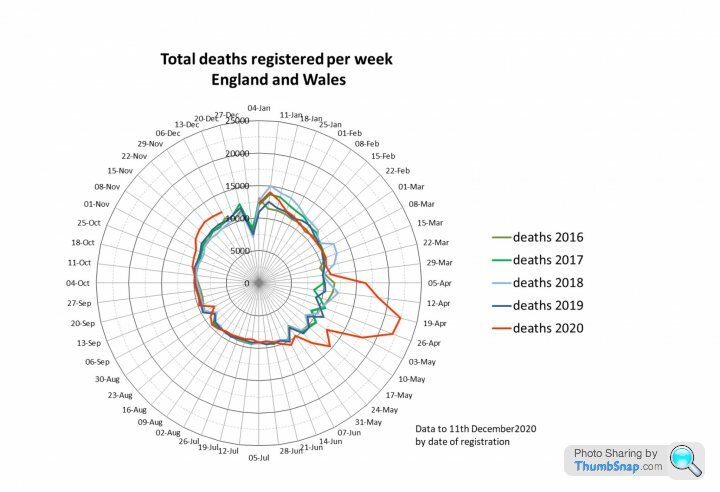
https://www.cebm.net/covid-19/covid-19-florence-ni...

https://www.cebm.net/covid-19/covid-19-florence-ni...
So far 
Just seen that the Gov staging site now provides positivity data at local authority level for England:
https://coronavirus.data.gov.uk/details/testing
Hastings, which is caught up in the 'Southern Surge' is hitting 15%
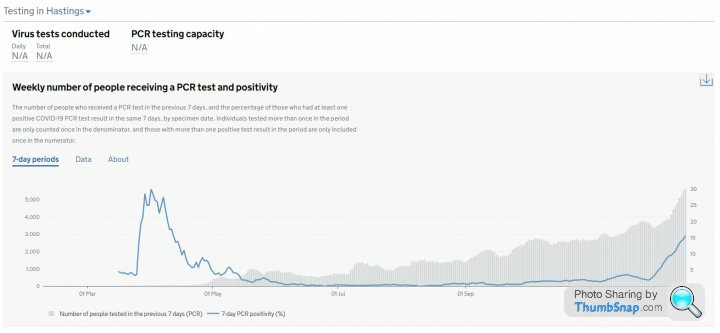
However, Liverpool and Nottingham were 19.9% and 32.5% respectively when they peaked:
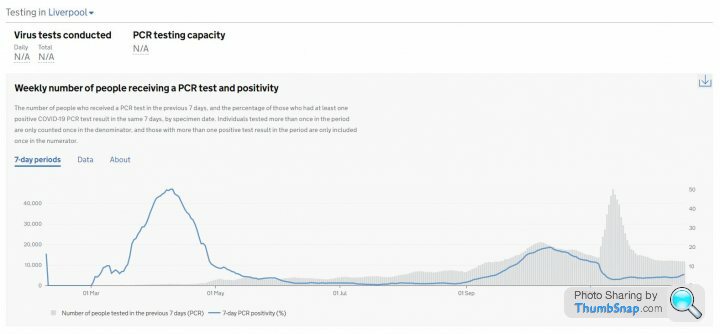
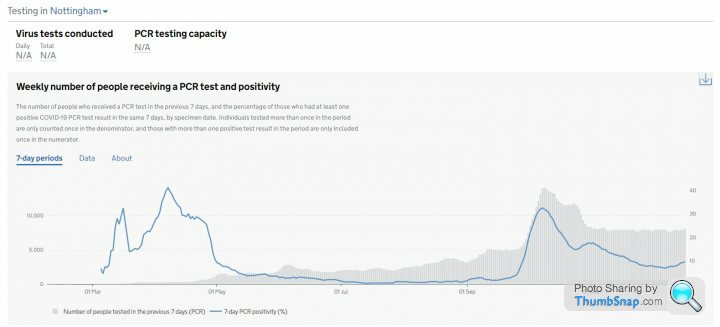
Interesting that positivity remained steady during Liverpools mass testing spike.

Just seen that the Gov staging site now provides positivity data at local authority level for England:
https://coronavirus.data.gov.uk/details/testing
Hastings, which is caught up in the 'Southern Surge' is hitting 15%

However, Liverpool and Nottingham were 19.9% and 32.5% respectively when they peaked:


Interesting that positivity remained steady during Liverpools mass testing spike.
WatchfulEye said:
Elysium said:
So far 
Interesting that positivity remained steady during Liverpools mass testing spike.
Perhaps, I'm misunderstanding you. But this was one of the unexpected findings of the mass testing programme in Liverpool - it found surprisingly few additional cases.
Interesting that positivity remained steady during Liverpools mass testing spike.
As your graph shows, as the mass testing program ramped up, the percentage of positive results plummeted - because the large increase in testing was not accompanied by a large increase in positive results. Before mass testing started, there were 13.7k tests per week, with a positivity rate of 11.4% (1560 new cases per week). At peak of mass testing a week later, there were 46.9k tests per week with a positivity rate of 3.2% (1500 cases per week).
One potential explanation which was raised locally was that there was poor engagement with mass testing (which was optional) by people in the highest risk population groups. To somewhat oversimplify, the more precautions people were taking (and therefore the less likely they were to contract it), the more likely they were to agree to testing.
Interesting that we see something similar in the latest data for Havering:
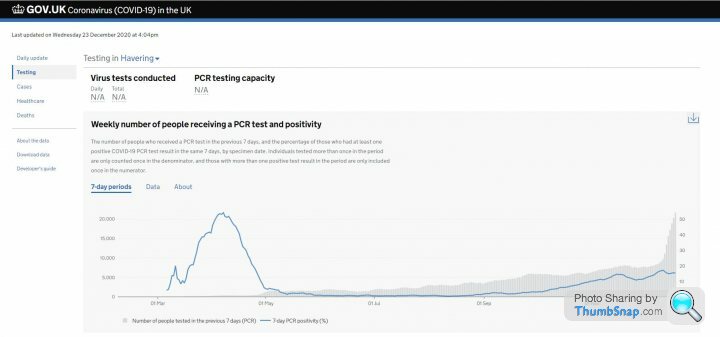
Edited by Elysium on Thursday 24th December 14:43
Gassing Station | News, Politics & Economics | Top of Page | What's New | My Stuff




